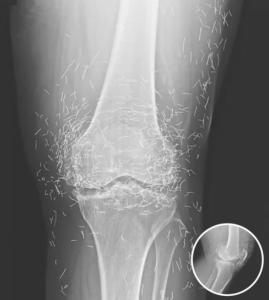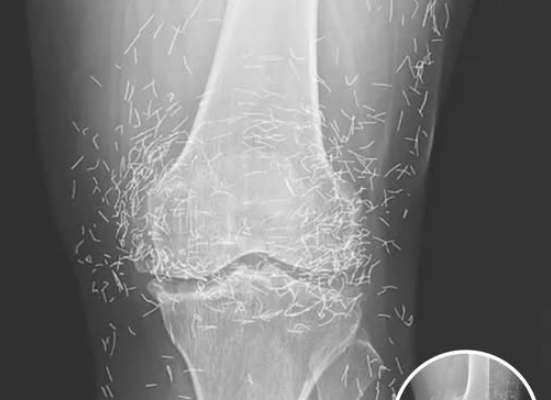✨ Golden Threads: A Story Etched in Bone
The image was haunting.
An X-ray, black and white, clinical and cold. But within the grayscale of bone and shadow, something shimmered—hundreds of tiny gold needles, scattered like stars across the knees of a 65-year-old woman. They weren’t accidental. They weren’t forgotten. They were placed with intention, left behind as part of a ritual of healing.
To the doctors, it was baffling. To the woman, it was familiar.
She had lived with pain for years. Osteoarthritis had crept into her joints like winter into an old house—slow, relentless, unforgiving. The cartilage wore thin. The bones rubbed raw. Every step was a negotiation. Pills helped, until they didn’t. Anti-inflammatories dulled the ache but tore at her stomach. Surgery was offered, but she hesitated. She didn’t want to be cut open. She wanted something gentler. Something older.
So she turned to acupuncture.
In South Korea, acupuncture isn’t fringe—it’s woven into the fabric of care. It’s not just about needles; it’s about balance, energy, and the belief that healing can be coaxed, not forced. Her practitioner suggested a method known as “gold thread implantation”—a technique where tiny gold needles are inserted and left in the tissue to provide continuous stimulation. The metal, they said, would harmonize with her body. It would stay. It would heal.
She agreed.
The procedure was quiet. No hospital gowns, no beeping machines. Just a room, a table, and the soft clink of gold. The needles were thin, almost invisible. They disappeared beneath her skin like secrets. She felt a warmth afterward, a lightness. She walked home slowly, knees wrapped in hope.
Years passed.
The pain ebbed and flowed. She forgot about the needles. They became part of her—silent companions in her joints. Until one day, the pain returned with fury. She went to the hospital. They took an X-ray. And there it was: a constellation of gold.
🩻 The Medical Gaze
The doctors were stunned. They had never seen anything like it. Hundreds of foreign objects, each one a potential risk. Gold may be inert, but the body is vigilant. It surrounds intruders with fibrous tissue. It inflames. It defends.
Dr. Ali Guermazi, a radiologist at Boston University, explained the dangers: inflammation, infection, abscesses. The needles could obscure anatomy, complicate diagnoses. Worse, they made MRIs impossible. The magnetic force could shift the metal, puncture vessels, cause damage.
But the woman was calm.
She listened. She nodded. She understood. And then she said something that lingered in the room:
“They were meant to help.”
🌿 The Ritual of Relief
There’s something profound in that statement. It speaks to the human desire for comfort—not just physical, but emotional. Pain isolates. It erodes dignity. And in the face of chronic suffering, people reach for meaning.
Gold needles aren’t just treatment. They’re ritual. They’re belief made tangible. They reflect a worldview where healing is slow, where the body is a landscape to be tended, not conquered. In some cultures, gold is sacred. It symbolizes purity, endurance, light. To embed it in the body is to invite those qualities inward.
Western medicine often struggles with this. It seeks evidence, trials, data. But healing is also narrative. It’s shaped by memory, culture, and trust. The woman’s choice wasn’t irrational—it was rooted in a tradition that values subtlety, patience, and the quiet power of touch.
🧵 Threads of Legacy
The image of her knees—lit with gold—became more than a medical anomaly. It became a metaphor.
Each needle was a thread in her story. A testament to her perseverance. A symbol of her refusal to surrender to pain. They marked her body not as broken, but as resilient. They were not scars. They were stitches.
And in a way, they connected her to others.
Online, the X-ray sparked fascination. Some saw it as strange. Others saw it as beautiful. A few shared their own stories—of acupuncture, of chronic pain, of the search for relief. The image became communal. It invited reflection.
What do we carry in our bodies?
What do we leave behind?
What do we choose to believe in, when science and suffering collide?
💬 The Quiet Resistance
There’s a quiet resistance in choosing alternative care. It’s not defiance—it’s dignity. It’s the belief that healing can be personal, that the body is not just a machine to be fixed, but a vessel to be honored.
The woman’s gold needles were not a rejection of medicine. They were a supplement. A gesture. A hope. And while they may have posed risks, they also offered relief. They gave her years of movement, of autonomy, of grace.
And perhaps that’s the deeper lesson.
Healing is not always clean. It’s messy, layered, imperfect. It’s shaped by culture, by access, by emotion. And sometimes, it glimmers unexpectedly—like gold in an X-ray.
🌟 The Final Image
The doctors eventually removed some of the needles. Others were left. The woman continued her care, blending tradition and science. Her knees still ached, but less. She walked slowly, but proudly.
And somewhere, in a hospital archive, that X-ray remains.
A portrait of pain. A map of belief. A story etched in bone.
Not just of a woman’s knees.
But of her journey.


